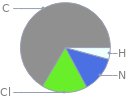Input interpretation

1, 10-phenanthroline monohydrochloride | elemental composition
Result

Find the elemental composition for 1, 10-phenanthroline monohydrochloride in terms of the atom and mass percents: atom percent = N_i/N_atoms × 100% mass percent = (N_im_i)/m × 100% Plan: • Write the chemical formula and gather atomic masses from the periodic table. • Determine values for N_i, m_i, N_atoms and m using these items. • Finally, compute the percents and check the results. Write the chemical formula: Use the chemical formula to count the number of atoms, N_i, for each element and find the total number of atoms, N_atoms, per molecule: | number of atoms C (carbon) | 12 Cl (chlorine) | 1 H (hydrogen) | 9 N (nitrogen) | 2 N_atoms = 12 + 1 + 9 + 2 = 24 Divide each N_i by N_atoms to calculate atom fractions. Then use the property that atom fractions must sum to one to check the work: | number of atoms | atom fraction C (carbon) | 12 | 12/24 Cl (chlorine) | 1 | 1/24 H (hydrogen) | 9 | 9/24 N (nitrogen) | 2 | 2/24 Check: 12/24 + 1/24 + 9/24 + 2/24 = 1 Compute atom percents using the atom fractions: | number of atoms | atom percent C (carbon) | 12 | 12/24 × 100% = 50.0% Cl (chlorine) | 1 | 1/24 × 100% = 4.17% H (hydrogen) | 9 | 9/24 × 100% = 37.5% N (nitrogen) | 2 | 2/24 × 100% = 8.33% Look up the atomic mass, m_i, in unified atomic mass units, u, for each element in the periodic table: | number of atoms | atom percent | atomic mass/u C (carbon) | 12 | 50.0% | 12.011 Cl (chlorine) | 1 | 4.17% | 35.45 H (hydrogen) | 9 | 37.5% | 1.008 N (nitrogen) | 2 | 8.33% | 14.007 Multiply N_i by m_i to compute the mass for each element. Then sum those values to compute the molecular mass, m: | number of atoms | atom percent | atomic mass/u | mass/u C (carbon) | 12 | 50.0% | 12.011 | 12 × 12.011 = 144.132 Cl (chlorine) | 1 | 4.17% | 35.45 | 1 × 35.45 = 35.45 H (hydrogen) | 9 | 37.5% | 1.008 | 9 × 1.008 = 9.072 N (nitrogen) | 2 | 8.33% | 14.007 | 2 × 14.007 = 28.014 m = 144.132 u + 35.45 u + 9.072 u + 28.014 u = 216.668 u Divide the mass for each element by m to calculate mass fractions. Then use the property that mass fractions must sum to one to check the work: | number of atoms | atom percent | mass fraction C (carbon) | 12 | 50.0% | 144.132/216.668 Cl (chlorine) | 1 | 4.17% | 35.45/216.668 H (hydrogen) | 9 | 37.5% | 9.072/216.668 N (nitrogen) | 2 | 8.33% | 28.014/216.668 Check: 144.132/216.668 + 35.45/216.668 + 9.072/216.668 + 28.014/216.668 = 1 Compute mass percents using the mass fractions: Answer: | | | number of atoms | atom percent | mass percent C (carbon) | 12 | 50.0% | 144.132/216.668 × 100% = 66.52% Cl (chlorine) | 1 | 4.17% | 35.45/216.668 × 100% = 16.36% H (hydrogen) | 9 | 37.5% | 9.072/216.668 × 100% = 4.187% N (nitrogen) | 2 | 8.33% | 28.014/216.668 × 100% = 12.93%
Mass fraction pie chart

Mass fraction pie chart